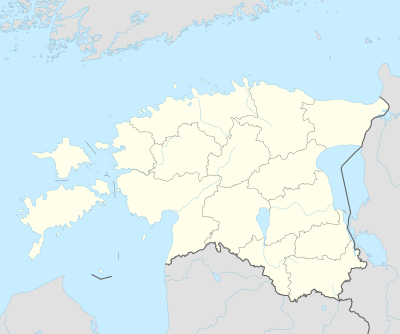Aegviidu
| Aegviidu | |||
|---|---|---|---|
| Borough with a municipality status | |||
 Aegviidu railway station | |||
| |||
 Aegviidu Location in Estonia | |||
| Coordinates: 59°17′11″N 25°36′36″E / 59.28639°N 25.61000°ECoordinates: 59°17′11″N 25°36′36″E / 59.28639°N 25.61000°E | |||
| Country |
| ||
| County |
| ||
| Administrative centre | Aegviidu | ||
| Government | |||
| • Mayor | Tõnis Väli | ||
| Area | |||
| • Total | 11.97 km2 (4.62 sq mi) | ||
| Population (01.01.2012[1]) | |||
| • Total | 838 | ||
| • Density | 70/km2 (180/sq mi) | ||
| Website | www.aegviidu.ee | ||
Aegviidu (Estonian for "Timespend") is a borough (Estonian: alev) in Anija Parish, in Harju County.
The borough has a population of 838 (as of 1 January 2012) and covers an area of 11.97 km2 (5 sq mi). The population density is 70.01/km2 (181.32/sq mi).[1]
Aegviidu is located in the crossing of the Tallinn–Saint Petersburg railway and Piibe Road (the historical Tallinn–Tartu road) in the boggy Kõrvemaa landscape region. The Aegviidu railway station is served by the Elron's Tallinn–Tartu and Tallinn–Narva lines, and is also used as the terminus of Tallinn–Aegviidu electric commuter trains.
History
Aegviidu was first mentioned as Aegwid in 1796 on Livonian map, drawn by count Ludwig August Mellin. In the 18th century Aegviidu was the location of Lehtse Manor's cattle and hunting manor named Charlottenhof. In 1820 the baron of Lehtse Manor established a coaching inn to serve the mail coaches on the Piibe Road, which was back then the main road connecting the cities Tallinn and Tartu. The building is now used as a schoolhouse. In 1870 the Tallinn–Saint Petersburg railway with a station in Aegviidu was opened. The railway brought a growth in the population. Many summer cottages were built in the nearby woods. In 1896 a church was built. In the beginning of the 20th century a post office, pharmacy and a store were opened. In 1926 Aegviidu gained a summering bourough rights after which it became a populer summering place. 1937–1938 a tourist centre was built on the shore of Lake Purgatsi in the southeastern part of Aegviidu in Nelijärve. The development of the settlement slowed down after the World War II when Estonia was occupied by the Soviet Union. The main employers were involved in the forest management. Aegviidu gained the borough (alev) rights in 1945. After the reindependence of Estonia in 1991, Aegviidu was given the rights of a municipality[2], until it was merged into Anija Parish in 2017.
Gallery
 Main building of Aegviidu railway station.
Main building of Aegviidu railway station. Water tower in the station
Water tower in the station
 Aegviidu St. Alexander's Church
Aegviidu St. Alexander's Church The main road (Piibe Road) in Aegviidu
The main road (Piibe Road) in Aegviidu- Lake Nikerjärv
 Lake Vahejärv
Lake Vahejärv- Lake Purgatsi
Notable people
- Jan Kaus (born 1971), writer, was born in Aegviidu.
- Anna Raudkats (1886–1965), dance pedagogue, is buried into Aegviidu cemetery
References
- 1 2 "Population figure and composition". Statistics Estonia. Retrieved 9 June 2012.
- ↑ "Ajalugu" (in Estonian). Aegviidu vald. Retrieved 16 October 2012.
External links
| Wikimedia Commons has media related to Aegviidu. |
- Official website (in Estonian)


